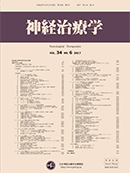36 巻, 4 号
選択された号の論文の73件中1~50を表示しています
-
2019 年36 巻4 号 p. 333-336
発行日: 2019年
公開日: 2020/04/24
PDF形式でダウンロード (400K)
第36回日本神経治療学会総会特集2
教育講演
-
2019 年36 巻4 号 p. 337-340
発行日: 2019年
公開日: 2020/04/24
PDF形式でダウンロード (468K) -
2019 年36 巻4 号 p. 341-344
発行日: 2019年
公開日: 2020/04/24
PDF形式でダウンロード (466K) -
2019 年36 巻4 号 p. 345-348
発行日: 2019年
公開日: 2020/04/24
PDF形式でダウンロード (391K) -
2019 年36 巻4 号 p. 349-353
発行日: 2019年
公開日: 2020/04/24
PDF形式でダウンロード (2098K) -
2019 年36 巻4 号 p. 354-358
発行日: 2019年
公開日: 2020/04/24
PDF形式でダウンロード (782K) -
2019 年36 巻4 号 p. 359
発行日: 2019年
公開日: 2020/04/24
PDF形式でダウンロード (187K) -
2019 年36 巻4 号 p. 360-366
発行日: 2019年
公開日: 2020/04/24
PDF形式でダウンロード (1656K) -
2019 年36 巻4 号 p. 367-371
発行日: 2019年
公開日: 2020/04/24
PDF形式でダウンロード (895K)
マラソンレクチャー
-
2019 年36 巻4 号 p. 372-376
発行日: 2019年
公開日: 2020/04/24
PDF形式でダウンロード (631K) -
2019 年36 巻4 号 p. 377-379
発行日: 2019年
公開日: 2020/04/24
PDF形式でダウンロード (907K) -
2019 年36 巻4 号 p. 380-383
発行日: 2019年
公開日: 2020/04/24
PDF形式でダウンロード (403K) -
2019 年36 巻4 号 p. 384-386
発行日: 2019年
公開日: 2020/04/24
PDF形式でダウンロード (325K) -
2019 年36 巻4 号 p. 387
発行日: 2019年
公開日: 2020/04/24
PDF形式でダウンロード (136K) -
2019 年36 巻4 号 p. 388-394
発行日: 2019年
公開日: 2020/04/24
PDF形式でダウンロード (1207K)
メディカルスタッフレクチャー
-
2019 年36 巻4 号 p. 395-398
発行日: 2019年
公開日: 2020/04/24
PDF形式でダウンロード (413K) -
2019 年36 巻4 号 p. 399-402
発行日: 2019年
公開日: 2020/04/24
PDF形式でダウンロード (405K) -
2019 年36 巻4 号 p. 403
発行日: 2019年
公開日: 2020/04/24
PDF形式でダウンロード (177K) -
2019 年36 巻4 号 p. 404-409
発行日: 2019年
公開日: 2020/04/24
PDF形式でダウンロード (2228K) -
2019 年36 巻4 号 p. 410-414
発行日: 2019年
公開日: 2020/04/24
PDF形式でダウンロード (606K) -
2019 年36 巻4 号 p. 415-421
発行日: 2019年
公開日: 2020/04/24
PDF形式でダウンロード (1187K) -
2019 年36 巻4 号 p. 422-427
発行日: 2019年
公開日: 2020/04/24
PDF形式でダウンロード (1014K)
シンポジウム8:GBS/CIDP:病態と治療の新たな展開
-
2019 年36 巻4 号 p. 428
発行日: 2019年
公開日: 2020/04/24
PDF形式でダウンロード (246K) -
2019 年36 巻4 号 p. 429-433
発行日: 2019年
公開日: 2020/04/24
PDF形式でダウンロード (894K) -
2019 年36 巻4 号 p. 434-437
発行日: 2019年
公開日: 2020/04/24
PDF形式でダウンロード (323K) -
2019 年36 巻4 号 p. 438
発行日: 2019年
公開日: 2020/04/24
PDF形式でダウンロード (200K) -
2019 年36 巻4 号 p. 439-444
発行日: 2019年
公開日: 2020/04/24
PDF形式でダウンロード (715K)
シンポジウム9:てんかんと痙攣のアップデート2018
-
2019 年36 巻4 号 p. 445
発行日: 2019年
公開日: 2020/04/24
PDF形式でダウンロード (80K) -
2019 年36 巻4 号 p. 446
発行日: 2019年
公開日: 2020/04/24
PDF形式でダウンロード (166K) -
2019 年36 巻4 号 p. 447-451
発行日: 2019年
公開日: 2020/04/24
PDF形式でダウンロード (2000K) -
2019 年36 巻4 号 p. 452
発行日: 2019年
公開日: 2020/04/24
PDF形式でダウンロード (185K) -
2019 年36 巻4 号 p. 453
発行日: 2019年
公開日: 2020/04/24
PDF形式でダウンロード (191K) -
2019 年36 巻4 号 p. 454-456
発行日: 2019年
公開日: 2020/04/24
PDF形式でダウンロード (416K) -
2019 年36 巻4 号 p. 457-460
発行日: 2019年
公開日: 2020/04/24
PDF形式でダウンロード (594K)
シンポジウム10:ALSに対する治験の最新情報
-
2019 年36 巻4 号 p. 461
発行日: 2019年
公開日: 2020/04/24
PDF形式でダウンロード (251K) -
2019 年36 巻4 号 p. 462-464
発行日: 2019年
公開日: 2020/04/24
PDF形式でダウンロード (332K) -
2019 年36 巻4 号 p. 465-470
発行日: 2019年
公開日: 2020/04/24
PDF形式でダウンロード (1604K) -
2019 年36 巻4 号 p. 471-476
発行日: 2019年
公開日: 2020/04/24
PDF形式でダウンロード (1326K) -
2019 年36 巻4 号 p. 477
発行日: 2019年
公開日: 2020/04/24
PDF形式でダウンロード (214K)
シンポジウム11:神経救急・集中治療における脳神経内科医のプレゼンスを高めるために
-
2019 年36 巻4 号 p. 478
発行日: 2019年
公開日: 2020/04/24
PDF形式でダウンロード (254K) -
2019 年36 巻4 号 p. 479-481
発行日: 2019年
公開日: 2020/04/24
PDF形式でダウンロード (1745K) -
2019 年36 巻4 号 p. 482
発行日: 2019年
公開日: 2020/04/24
PDF形式でダウンロード (202K) -
2019 年36 巻4 号 p. 483-485
発行日: 2019年
公開日: 2020/04/24
PDF形式でダウンロード (438K) -
2019 年36 巻4 号 p. 486
発行日: 2019年
公開日: 2020/04/24
PDF形式でダウンロード (163K) -
2019 年36 巻4 号 p. 487-491
発行日: 2019年
公開日: 2020/04/24
PDF形式でダウンロード (1940K) -
2019 年36 巻4 号 p. 492-497
発行日: 2019年
公開日: 2020/04/24
PDF形式でダウンロード (1168K) -
2019 年36 巻4 号 p. 498
発行日: 2019年
公開日: 2020/04/24
PDF形式でダウンロード (213K) -
2019 年36 巻4 号 p. 499
発行日: 2019年
公開日: 2020/04/24
PDF形式でダウンロード (217K)
シンポジウム12:種々の症状を呈する難治性疾患における中枢神経感作の役割の解明とそれによる患者ケアの向上
-
2019 年36 巻4 号 p. 500
発行日: 2019年
公開日: 2020/04/24
PDF形式でダウンロード (282K) -
2019 年36 巻4 号 p. 501-504
発行日: 2019年
公開日: 2020/04/24
PDF形式でダウンロード (1103K)
